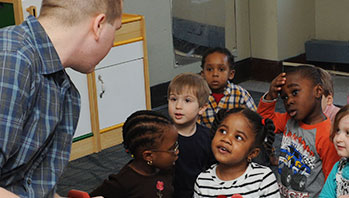- pictures of ramps
- machine
- ramp
MA Standards:
Speaking and Listening/SL.PK.MA.1: Participate in collaborative conversations with diverse partners during daily routines and play.
Language/L.PK.MA.1 Demonstrate use of oral language in informal everyday activities.
Language/L.PK.MA.6: Use words and phrases acquired through conversations, listening to books read aloud, activities, and play.
Head Start Outcomes:
Language Development/Receptive Language: Attends to language during conversations, songs, stories, or other learning experiences.
Language Development/Expressive Language: Uses language to express ideas and needs.
PreK Learning Guidelines:
English Language Arts/Language 2: Participate actively in discussions, listen to the ideas of others, and ask and answer relevant questions.
Talk Together: Simple Machines

© Commonwealth of Massachusetts, Department of Early Education and Care (Jennifer Waddell photographer). All rights reserved.
STEM Key Concepts: Identify tools and simple machines used for a specific purpose, e.g., ramp, wheel, pulley, lever
ELA Focus Skills: Concepts of Print, Speaking and Listening, Vocabulary
Hold up a picture of a ramp (e.g., a tow truck with a car going up the ramp). Ask, What is the man using to help him get the car up onto the tow truck? (ramp) Explain that the ramp is a machine. Say,
- The ramp is a tool that helps make the man’s work easier. A ramp is sometimes called a simple machine.
- Display pictures of ramps making work easier for someone (e.g., a horse climbing a ramp into a horse truck, a luggage ramp, builders sending cement down a ramp). Discuss how these jobs would be more difficult or impossible to do without this machine.
- Help children gain an understanding that there are many machines people use to help make their work easier, such as a computer, airplane, or washing machine.
English Language Learners: Point out the pronunciation similarities between the English and Spanish words machine/máquina to help bridge understanding of the vocabulary word. Demonstrate other word meanings with gestures and expressions. Have children repeat each word and gesture after you.
